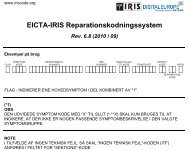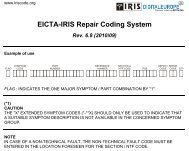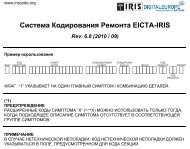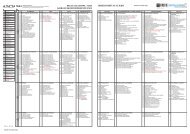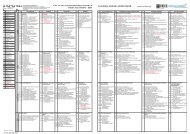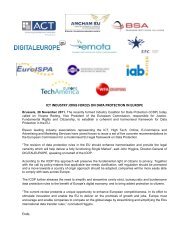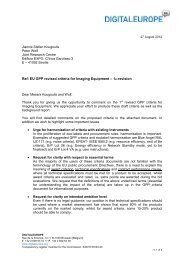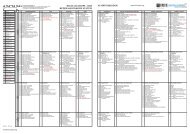Standardized DVB-T2 RF specifications - DigitalEurope
Standardized DVB-T2 RF specifications - DigitalEurope
Standardized DVB-T2 RF specifications - DigitalEurope
You also want an ePaper? Increase the reach of your titles
YUMPU automatically turns print PDFs into web optimized ePapers that Google loves.
(C/N)0dB_table_44 = 0dB echo C/N for genie aided simulation (table 44 of ref.1)<br />
(C/N)AWGN_table_44 = AWGN C/N for genie aided simulation (table 44 of ref.1)<br />
IL(CR) = code rate dependent implementation loss due to additional losses in a 0dB<br />
echo channel. These are 1.0, 1.2, 1.4, 1.6, 1.8, 2.0 dB for 1/2 rate to 5/6 rate<br />
respectively). These have been verified on several different receiver implementations.<br />
7- AWGN C/N PE<strong>RF</strong>ORMANCE<br />
The receiver should have the performance given in Table 2 when noise (N) is applied<br />
together with the wanted carrier (C) in a signal bandwidth of 7.61, 7.71 & 7.77 MHz<br />
depending upon mode. The values are calculated using a receiver backstop noise value Px<br />
of -33 dBc. An ideal transmitter is assumed. The <strong>DVB</strong>-<strong>T2</strong> signal is set to -50dBm at the tuner<br />
input.<br />
Table 2 - C/N (dB) for PFP1<br />
Mode Details<br />
Gaussian PFP1<br />
dB<br />
1 8KE QPSK 1/2 1/16 PP4 3.6<br />
2 16KE 16 QAM 2/3 19/128PP3 11.5<br />
3 16KE 64 QAM 2/3 19/256 PP2 16.7<br />
4 16KN 256 QAM 3/5 1/32 PP4 19.5<br />
5 32KN 256 QAM 3/5 1/32 PP4 19.4<br />
6 32KN 256 QAM 3/5 1/8 PP2 19.9<br />
7 32KE 256 QAM 2/3 1/128 PP7 20.3<br />
8 32KE 256 QAM 2/3 1/16 PP4 20.9<br />
9 32KE 256 QAM 3/4 1/32 PP6 22.4<br />
8- IMMUNITY TO ANALOGUE AND DIGITAL SIGNALS IN OTHER CHANNELS<br />
8- 1- General notes for testing<br />
All TV interferer signals are held at a constant at -25dBm at the tuner input whilst the wanted<br />
signal is attenuated until PFP1 is obtained.<br />
The <strong>RF</strong> signal should be broken after each change in wanted signal level to ensure the<br />
receiver re-acquires. This is to ensure any weaknesses in the receiver acquisition processes<br />
are included in the overall result.<br />
A band pass filter on the interference source is normally needed on N±3 measurements and<br />
beyond to achieve accurate results by reducing out of band interference from the<br />
interference source.<br />
>>5 of 27



